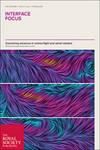Effects of mineralization on the hierarchical organization of collagen—a synchrotron X-ray scattering and polarized second harmonic generation study
IF 3.6
3区 生物学
Q1 BIOLOGY
引用次数: 1
Abstract
The process of mineralization fundamentally alters collagenous tissue biomechanics. While the structure and organization of mineral particles have been widely studied, the impact of mineralization on collagen matrix structure, particularly at the molecular scale, requires further investigation. In this study, synchrotron X-ray scattering (XRD) and polarization-resolved second harmonic generation microscopy (pSHG) were used to study normally mineralizing turkey leg tendon in tissue zones representing different stages of mineralization. XRD data demonstrated statistically significant differences in collagen D-period, intermolecular spacing, fibril and molecular dispersion and relative supramolecular twists between non-mineralizing, early mineralizing and late mineralizing zones. pSHG analysis of the same tendon zones showed the degree of collagen fibril organization was significantly greater in early and late mineralizing zones compared to non-mineralizing zones. The combination of XRD and pSHG data provide new insights into hierarchical collagen–mineral interactions, notably concerning possible cleavage of intra- or interfibrillar bonds, occlusion and reorganization of collagen by mineral with time. The complementary application of XRD and fast, label-free and non-destructive pSHG optical measurements presents a pathway for future investigations into the dynamics of molecular scale changes in collagen in the presence of increasing mineral deposition.矿化对胶原分层组织的影响--同步辐射 X 射线散射和偏振二次谐波发生研究
矿化过程从根本上改变了胶原组织的生物力学。虽然矿物颗粒的结构和组织已被广泛研究,但矿化对胶原基质结构的影响,尤其是在分子尺度上的影响,还需要进一步研究。本研究采用同步辐射 X 射线散射 (XRD) 和偏振分辨二次谐波发生显微镜 (pSHG) 对代表不同矿化阶段的组织区域中正常矿化的火鸡腿肌腱进行了研究。XRD 数据显示,非矿化区、早期矿化区和晚期矿化区之间的胶原蛋白 D 周期、分子间距、纤维和分子分散性以及相对超分子扭曲程度存在显著的统计学差异。XRD 和 pSHG 数据的结合为分层胶原蛋白-矿物质相互作用提供了新的视角,特别是关于可能的纤维内或纤维间键的裂解、矿物质对胶原蛋白的堵塞和重组。XRD 与快速、无标记和无损 pSHG 光学测量的互补应用为未来研究矿物质沉积增加时胶原蛋白分子尺度的动态变化提供了一条途径。
本文章由计算机程序翻译,如有差异,请以英文原文为准。
求助全文
约1分钟内获得全文
求助全文
来源期刊

Interface Focus
BIOLOGY-
CiteScore
9.20
自引率
0.00%
发文量
44
审稿时长
6-12 weeks
期刊介绍:
Each Interface Focus themed issue is devoted to a particular subject at the interface of the physical and life sciences. Formed of high-quality articles, they aim to facilitate cross-disciplinary research across this traditional divide by acting as a forum accessible to all. Topics may be newly emerging areas of research or dynamic aspects of more established fields. Organisers of each Interface Focus are strongly encouraged to contextualise the journal within their chosen subject.
文献相关原料
| 公司名称 | 产品信息 | 采购帮参考价格 |
|---|
 求助内容:
求助内容: 应助结果提醒方式:
应助结果提醒方式:


